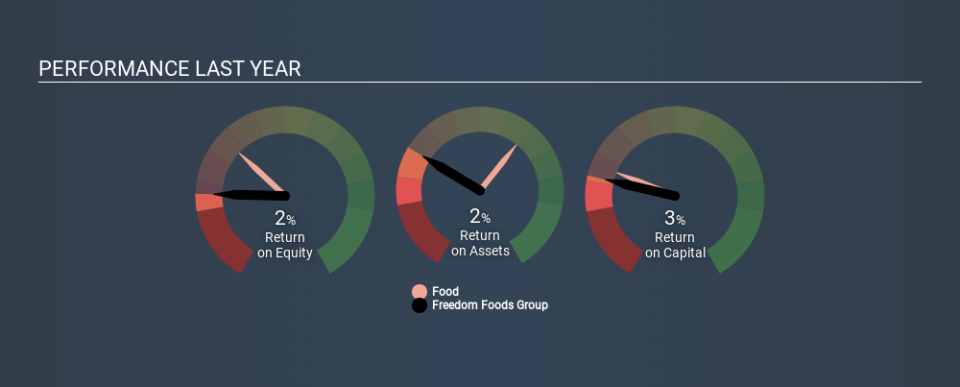Freedom Foods Group Limited (ASX:FNP) Might Not Be A Great Investment

Today we'll evaluate Freedom Foods Group Limited (ASX:FNP) to determine whether it could have potential as an investment idea. To be precise, we'll consider its Return On Capital Employed (ROCE), as that will inform our view of the quality of the business.
First of all, we'll work out how to calculate ROCE. Then we'll compare its ROCE to similar companies. And finally, we'll look at how its current liabilities are impacting its ROCE.
Return On Capital Employed (ROCE): What is it?
ROCE measures the 'return' (pre-tax profit) a company generates from capital employed in its business. Generally speaking a higher ROCE is better. Ultimately, it is a useful but imperfect metric. Author Edwin Whiting says to be careful when comparing the ROCE of different businesses, since 'No two businesses are exactly alike.
So, How Do We Calculate ROCE?
The formula for calculating the return on capital employed is:
Return on Capital Employed = Earnings Before Interest and Tax (EBIT) ÷ (Total Assets - Current Liabilities)
Or for Freedom Foods Group:
0.028 = AU$27m ÷ (AU$1.1b - AU$171m) (Based on the trailing twelve months to December 2019.)
So, Freedom Foods Group has an ROCE of 2.8%.
See our latest analysis for Freedom Foods Group
Is Freedom Foods Group's ROCE Good?
ROCE is commonly used for comparing the performance of similar businesses. In this analysis, Freedom Foods Group's ROCE appears meaningfully below the 6.9% average reported by the Food industry. This performance is not ideal, as it suggests the company may not be deploying its capital as effectively as some competitors. Independently of how Freedom Foods Group compares to its industry, its ROCE in absolute terms is low; especially compared to the ~1.1% available in government bonds. It is likely that there are more attractive prospects out there.
Freedom Foods Group's current ROCE of 2.8% is lower than its ROCE in the past, which was 3.8%, 3 years ago. This makes us wonder if the business is facing new challenges. You can click on the image below to see (in greater detail) how Freedom Foods Group's past growth compares to other companies.
When considering this metric, keep in mind that it is backwards looking, and not necessarily predictive. ROCE can be misleading for companies in cyclical industries, with returns looking impressive during the boom times, but very weak during the busts. This is because ROCE only looks at one year, instead of considering returns across a whole cycle. What happens in the future is pretty important for investors, so we have prepared a free report on analyst forecasts for Freedom Foods Group.
What Are Current Liabilities, And How Do They Affect Freedom Foods Group's ROCE?
Short term (or current) liabilities, are things like supplier invoices, overdrafts, or tax bills that need to be paid within 12 months. Due to the way ROCE is calculated, a high level of current liabilities makes a company look as though it has less capital employed, and thus can (sometimes unfairly) boost the ROCE. To counter this, investors can check if a company has high current liabilities relative to total assets.
Freedom Foods Group has total assets of AU$1.1b and current liabilities of AU$171m. Therefore its current liabilities are equivalent to approximately 15% of its total assets. This is not a high level of current liabilities, which would not boost the ROCE by much.
Our Take On Freedom Foods Group's ROCE
Freedom Foods Group has a poor ROCE, and there may be better investment prospects out there. Of course, you might also be able to find a better stock than Freedom Foods Group. So you may wish to see this free collection of other companies that have grown earnings strongly.
Freedom Foods Group is not the only stock that insiders are buying. For those who like to find winning investments this free list of growing companies with recent insider purchasing, could be just the ticket.
If you spot an error that warrants correction, please contact the editor at editorial-team@simplywallst.com. This article by Simply Wall St is general in nature. It does not constitute a recommendation to buy or sell any stock, and does not take account of your objectives, or your financial situation. Simply Wall St has no position in the stocks mentioned.
We aim to bring you long-term focused research analysis driven by fundamental data. Note that our analysis may not factor in the latest price-sensitive company announcements or qualitative material. Thank you for reading.

 Yahoo Finance
Yahoo Finance 
